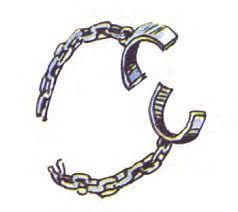Class 9 Social Science Chapter 1 Assertion and Reason Questions - The French Revolution
Directions: In the questions given below, there are two statements marked as Assertion (A) and Reason (R). Read the statements and choose the correct option.
Question 1:
Assertion (A): Robespierre's government issued laws placing a maximum ceiling on wages and prices. Meat and bread were rationed.
Reason (R): Peasants were forced to transport their grain to the cities and sell it at prices fixed by the Government.
(a) Both A and R are true and R is the correct explanation of A.
(b) Both A and R are true but R is not the correct explanation of A.
(c) A is correct but R is wrong.
(d) A is wrong but R is correct.
Correct Answer is Option (a)
- Robespierre was a radical democrat from France, who wanted to overthrow the monarchy and wanted the french people to form a government.
- He became the leader of the Jacobins club in France and gained the power to rule France.
- He was the greatest defender of the rights of the poor and believed in the concept of altruism or selflessness.
- He wanted people to be treated equally before the law, hence introducing measures to ensure equality.
- The Convention charged him and his supporters and his reign of terror came to an end.
- He was later executed, mostly guillotined within two days of his arrest.
Question 2:
Assertion (A): It was finally in 1946 that women in France won the Right to Vote.
Reason (R): The example of the political activities of French women during the revolutionary years was kept alive as an inspiring memory.
(a) Both A and R are true and R is the correct explanation of A.
(b) Both A and R are true but R is not the correct explanation of A.
(c) A is correct but R is wrong.
(d) A is wrong but R is correct.
Correct Answer is Option (b)
Women’s movements for voting rights and equal wages continued through the next two hundred years in many countries of the world. The fight for the vote was carried out through an international suffrage movement during the late nineteenth and early twentieth centuries. The example of the political activities of French women during the revolutionary years was kept alive as an inspiring memory. It was finally in 1946 that women in France won the right to vote.

Question 3:
Assertion (A): Strength lies in unity.
Reason (R): One rod can be easily broken, but not an entire bundle.
(a) Both A and R are true and R is the correct explanation of A.
(b) Both A and R are true but R is not the correct explanation of A.
(c) A is correct but R is wrong.
(d) A is wrong but R is correct.
Correct Answer is Option (a) Both A and R are true and R is the correct explanation of A.
This is completely true that strength lies in unity. Every work can be done easily and effectively if everyone is together because strength is highlighted as a product of unity. This can be explained by an old story. There was a father who had four sons. They always kept fighting and their father was old. So, he was ill because of his health and thought if he will die then how their sons will live together and do work. He got an idea and called all his sons. He gave one rod to each son and told them to break. Rods were easily broken down. Then he gave a bundle of the rod to them and asked them to beak now. No one was able to do that, then he explained to them that this is the power and strength of unity. If you all will be together then no one can harm you. They understood his father’s talk very well and lived happily after then.
Question 4:
Assertion (A): A broken chain stands for the act of becoming free.
Reason (R): Chains were used to fetter slaves.
(a) Both A and R are true and R is the correct explanation of A.
(b) Both A and R are true but R is not the correct explanation of A.
(c) A is correct but R is wrong.
(d) A is wrong but R is correct.
Correct Answer is Option (a)
A broken chain stands for the act of becoming free. The symbol of broken chain represents Freedom. It signifies freedom from slavery. In terms of the French Revolution, the broken chain signified freedom for the peasants and the third estate i.e. normal people as opposed to the aristocracy. Chains were used to fetter slaves. A broken chain symbolises the freedom from slavery.
 A Broken Chain
A Broken Chain
Question 5:
Assertion (A): The news spread that Louis XVI planned to impose further taxes.
Reason (R): To meet the expenses of the state generated anger and protest against the system of privileges.
(a) Both A and R are true and R is the correct explanation of A.
(b) Both A and R are true but R is not the correct explanation of A.
(c) A is correct but R is wrong.
(d) A is wrong but R is correct.
Correct Answer is Option (a)
The reason behind the anger and protest protest against the System of Privileges during Louis XVI old regime was;
Imposition of taxes: The government under the System of Privileges, gave the power to decide and perform a certain task was given to the king and his statesmen. In this, Louis XVI had already imposed several taxes which were to be paid by the working class. Further imposition of taxes led to anger and resentment.
Question 6:
Assertion (A): So the price of bread which was the staple diet of the majority rose rapidly.
Reason (R): Production of grains could not keep pace with the demand.
(a) Both A and R are true and R is the correct explanation of A.
(b) Both A and R are true but R is not the correct explanation of A.
(c) A is correct but R is wrong.
(d) A is wrong but R is correct.
Correct Answer is Option (a)
The population of France rose from about 23 million in 1715 to 28 million in 1789. This led to a rapid increase in the demand for food grains. Production of grains could not keep pace with the demand. So the price of bread which was the staple diet of the majority rose rapidly.
Question 7:
Assertion (A): During the eighteenth century France witnessed the emergence of a middle class.
Reason (R): The emergence of the middle class happened on account of royal patronage.
(a) Both A and R are true and R is the correct explanation of A.
(b) Both A and R are true but R is not the correct explanation of A.
(c) A is correct but R is wrong.
(d) A is wrong but R is correct.
Correct Answer is Option (c)
The eighteenth century witnessed the emergence of social groups, termed the middle class, who earned their wealth through an expanding overseas trade and from the manufacture of goods such as woollen and silk textiles that were either exported or bought by the richer members of society. In addition to merchants and manufacturers, the third estate included professions such as lawyers or administrative officials. All of these were educated and believed that no group in society should be privileged by birth. Rather, a person’s social position must depend on his merit.

Question 8:
Assertion (A): In many ways, the French Revolution was a very significant event in the history of the world.
Reason (R): The French Revolution not only inspired French citizens to take action, but it inspired many philosophers and leaders across the globe.
(a) Both A and R are true and R is the correct explanation of A.
(b) Both A and R are true but R is not the correct explanation of A.
(c) A is correct but R is wrong.
(d) A is wrong but R is correct.
Correct Answer is Option (a)
The French Revolution is called “The Dawn of Modern Era”. It ended a medieval society dominated by kings, priests, and nobles, signalling the beginning of a new era - The Modern Era. It also inspired nationalist leaders like Tipu Sultan and Rammohan Roy, and philosophers like Karl Marx.
Question 9:
Assertion (A): In 1805, Napoleon Bonaparte crowned himself Emperor of France.
Reason (R): Initially, many saw him as a liberator who would bring freedom for the people.
(a) Both A and R are true and R is the correct explanation of A.
(b) Both A and R are true but R is not the correct explanation of A.
(c) A is correct but R is wrong.
(d) A is wrong but R is correct.
Correct Answer is Option (d)
France was ruled by the Directory, an executive made up of five members.
(i) However, the Directors often clashed with the Legislative Councils, who then sought to dismiss them.
(ii) The political instability of the Directory paved the way for the rise of a military dictator, Napoleon Bonaparte.
(iii) After crowning himself as Emperor of France in 1804, he went out to conquer the neighboring European countries, dispossessing dynasties and creating kingdoms where he placed members of his family.
(iv) Initially, he was viewed as a liberator who would bring freedom to the people, but soon the Napoleonic armies came to be viewed everywhere as an invading force.
Question 10:
Assertion: From the very beginning, the French revolutionaries introduced various measures and practices like the idea of la Patrie and le citoyen.
Reason: This was done to create a sense of collective identity amongst the French people.
(a) Both A and R are true and R is the correct explanation of A.
(b) Both A and R are true but R is not the correct explanation of A.
(c) A is correct but R is wrong.
(d) A is wrong but R is correct.
Correct Answer is Option (a)
The French Revolution proclaimed that it was the people who would henceforth
constitute the nation and shape its destiny. From the very beginning, the French
Revolutionaries introduced various measures and practices that would create a
sense of collective identity amongst the French people. The centralised
administrative system was one of the measures taken for making uniform laws
for all citizens within its territory.
Cover detailed chapter notes of Class 9 History Chapter " The French Revolution" here: Detailed Chapter Notes: French Revolution
|
55 videos|635 docs|79 tests
|
FAQs on Class 9 Social Science Chapter 1 Assertion and Reason Questions - The French Revolution
| 1. Quels étaient les principaux causes de la Révolution française ? |  |
| 2. Quel rôle a joué la Déclaration des droits de l'homme et du citoyen dans la Révolution française ? |  |
| 3. Comment la Révolution française a-t-elle affecté les autres pays européens ? |  |
| 4. Quelles étaient les conséquences sociales de la Révolution française ? |  |
| 5. Quel impact la Révolution française a-t-elle eu sur le concept de démocratie ? |  |

















